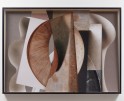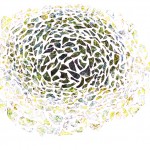Josh Raftery: Start the Story at the End
This week, we will be exploring projects inspired by intimacy and memory. Today, we’ll be looking at Josh Raftery’s series Start the Story at the End.
I was lucky to work with Josh Raftery in graduate school. At East Carolina University, Josh began working as a Visiting Instructor the year I started pursuing my MFA. We bonded over the Midwest and alternative processes. I remember spending many weeks perfecting my palladium processes while struggling through carbon transfers. Throughout it all, Josh was able to help us understand the ways we can marry concepts with process. He seamlessly wove historical stories in with the scientific techniques to using a variety of alternative processes. Throughout his time at ECU, Josh brought out a more poetic understanding of photography in his students’ work; something he does throughout his own images. Start the Story at the End is his most recent exploration of these ideas, exploring poetry, intimacy, loss, and memory.
Josh Raftery is a native of Phoenix, Arizona, where he studied forensic science and photography. He received his BFA in Photography from Arizona State University in 2011, and his MFA from Ohio University in Photography + Integrated Media in 2015. His current photographic work examines the relationships between loss, intimacy, memory, religion, science, and the tangible nature of existence. Raftery specializes in antiquated photographic processes to emphasize the passage of time. Raftery’s work has been exhibited both nationally and internationally, as well as included in several publications. He has been an instructor of photography at Ohio University, the University of Kentucky, a Visiting Instructor of Photography at East Carolina University, an instructor at the University a Visiting instructor of Photography at Eastern Oregon University and now works at Baylor University and resides in Waco, Texas.
Start the Story at the End
Start the Story at the End is a autobiographical survey of significant memories. Many of these images reflect early memories of trauma, hope of reconciliation and to better understand our existence on this giant floating rock that we call home. In 2020, the world experienced an overwhelming sense of loss, fear and uncertainty. During this, a dear friend of mine said to me while starring at a passerby and she said, “If everyone could tell their story, they could build a library.” This is my story of loss and grief during uncertain times.
With her words in mind, I began photographing familiar places where something had happened, while considering the memories of those who are no longer here. I began exploring this work in 2020, but never processed the film until the later part of 2023. I would not see these images until 3+ years later – it was an unsettling experience in that I did not immediately know where they came from, as significant as they were.
This work is a printed in the cyanotype process – formally known as the “disappearing print,” just as our memories slowly disappears and become further away from the objective truth. This will ultimately become a series of cyanotypes, scanned journal entries, found objects and creative non-fictional storytelling.
This is an on-going project, and very much in its infancy. Below is a sample of the written element of the work.
Start the Story from the End
The mind is an emulation of the ocean
they hold monsters,
and hide their secrets.
We started out, just running out
where memories are a fleeting landscape
Endless blue, and a sky filled of grey ash
There is nothing but
inconceivable loss
A loss they only endure
Take this with you, she said,
so you can remember me
A cactus skeleton
a fallen crow
They are relegated into the crypt
with only a vault of regional memories
Its liberating being nomadic,
unless you’re carrying a heavy heart on your back
the old man said
In the hopelessness of night,
they are visited by
ghosts and witches
taunting tricksters
They sweat in distress for understanding
until days later
bitten by the bat, they see ghosts who are not there
only partial skeletons
illuminated by the moon
Reality becomes synonymous with fiction
he seizes
I’ll stay drunk, he said to the burning sky,
To keep the ghosts and the pythonesses at bay
What a hell of a way to die
Please, will you start the story at the end? She asked.
I’ll meet you in the halls of Valhalla
Epiphany Knedler: How did your project come about?
Josh Raftery: This project came about in 2020 during the pandemic. We witnessed and experienced the uncertainty of the pandemic. For myself, I was experiencing my own precarious life changing events of loss and inconceivable grief. From 2020 – 2023, I began taking these images but never processed the film. It wasn’t until the end of 2023 that I started developing the film – which I had long forgotten what was on the reels – around 40+ rolls of film in all. It was certainly a strange experience to see the negatives on the light table and not immediately recognizing where / when I took those images. The poignant “ah-ha!” moment where I recognized where these spaces and places were captured. Early in 2024, I began curating the images to print, and the common thread was I gravitated towards were the images where something had happened. Usually an experience of loss, trauma, and melancholy memories. While curating these images, I was thinking about the overarching theme of “distance” in a metaphorical sense. Thus, I choose cyanotype as the process to print – blue has implications of longing, loss, and reaching for the unreachable.
I decided to include non-fictional writing – perhaps as a zine, journal entries and scans of found objects during this time.
EK: What relationship does memory or intimacy play within your practice, and does photography become a way to navigate these complex topics?
JR: I am always searching for meaning of memory and intimacy. I believe photographing is a very private and intimate act. Memory and history have always been curious avenue I find myself going down a rabbit-hole. Particularly, funerary practices throughout history by cultures, how we honor the dead, and scientific investigations that take place, while simultaneously critiquing my own experiences of loss and uncertainty.
EK: Is there a specific image that is your favorite or particularly meaningful to this series?
JR: I cannot say that there’s a particular image that is my “favorite.” They all hold a special place in my heart about where we (I and the departed) had a very special experience. For example, I’m currently working on an image that will be titled Ghost Fields, where there’s a grassy hill where my friends and I would rendezvous in high school. Many of them are no longer here. When I look at this seemingly banal landscape images, the memories for me and others hold great weight, and I hope once the writing is completed, the viewer will have a similar story.
EK: Can you tell us about your artistic practice?
JR: I usually have a plan. I map things out, make necessary arrangements, create sketches make notes etc. … But with Start the Story at the End, it was all happenstance – I responded to my surrounding, history, the relationship I have with my friends and family, and to capture the memories and places that I found significant. Even if that memory wasn’t intimately connected to me (i.e. the house that my father grew up in), I still felt compelled to preserve that memory. Although there was no direct correlation to my own memories, it’s still, in a way, a part of me. Anyone who has worked alongside of me before, I work slow, and I like to experiment. Currently, I’m debating toning the cyanotypes.
I like to play in the darkroom. So, whenever I embark on new work, the questions remain “What process do I want to print it in? Which images do I want to print? How is the writing going to impact the work etc.”.
At the time, I sincerely had no idea what I was going to make, or what story I wanted to tell until 3+ years later. This was certainly a creative path that was new for me.
EK: What’s next for you?
JR: I am currently still working on processing the film, making prints, contemplating making the prints toned … and basically trying to make all of this make sense to the viewer in telling this story.
The prints might be toned in the future, maybe not?
I do have a solo exhibition at Arts Center East in La Grande, Oregon in September 2024.
Epiphany Knedler is an interdisciplinary artist + educator exploring the ways we engage with history. She graduated from the University of South Dakota with a BFA in Studio Art and a BA in Political Science and completed her MFA in Studio Art at East Carolina University. She is based in Aberdeen, South Dakota, serving as a Lecturer of Art and the co-curator for the art collective Midwest Nice Art. Her work has been exhibited in the New York Times, Vermont Center for Photography, Lenscratch, Dek Unu Arts, and awarded through the Lucie Foundation, F-Stop Magazine, and Photolucida Critical Mass.
Follow Epiphany Knedler on Instagram: @epiphanysk
Posts on Lenscratch may not be reproduced without the permission of the Lenscratch staff and the photographer.
Recommended
-
The Female Gaze: Alysia Macaulay – Forms Uniquely Her OwnDecember 17th, 2025
-
Bill Armstrong: All A Blur: Photographs from the Infinity SeriesNovember 17th, 2025
-
Robert Rauschenberg at Gemini G.E.LOctober 18th, 2025
-
Erin Shirreff: Permanent DraftsAugust 24th, 2025
-
Shelagh Howard: The Secret KeepersJuly 7th, 2025































































